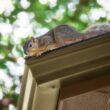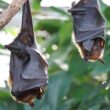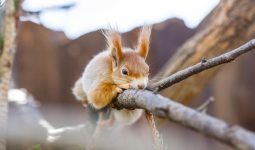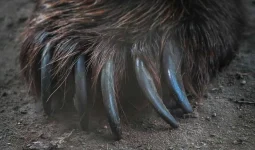Tennessee ranks fifth among all U.S. states where you’re most likely to encounter a dangerous animal.
From the Great Smoky Mountains to the Mississippi River corridor, the Volunteer State hosts an impressive array of wildlife that can pose serious threats to outdoor enthusiasts.
Whether you’re hiking through dense forests, camping under the stars, or simply enjoying your backyard, understanding these potential dangers could save your life.
This guide reveals the 15 most dangerous animals you’ll encounter in Tennessee, complete with identification tips, habitat information, and proven strategies to stay safe during your outdoor adventures.
Brown Recluse Spider
The brown recluse spider earns its fearsome reputation through its devastating bite effects. These yellowish-brown arachnids feature the distinctive violin-shaped marking on their bodies, making them somewhat easier to identify than other dangerous spiders.
Pro Tip: Brown recluses prefer dimly lit locations like dark corners in basements, closets, cluttered areas, or even inside shoes and beds. They hibernate during winter months and become active again in February or March.
What makes brown recluse bites particularly dangerous is their initially painless nature. You might not realize you’ve been bitten until serious symptoms develop, including lesions, nausea, and necrotic wounds where body tissue begins to rot and fall away. The CDC estimates that venomous spider bites affect thousands of Americans annually, making proper identification crucial for Tennessee residents.
Brown recluses can be found both indoors and outside throughout Tennessee, making complete avoidance nearly impossible. They often hide in woodpiles, under benches or stones, near abandoned rodent burrows, and around outbuildings. Inside homes, check dark corners, closets, and storage areas regularly.
Coyote
Coyotes have dramatically expanded their range in Tennessee over the past few decades, filling the ecological void left by the near-extinction of wolves. These adaptable predators now thrive throughout the state, from urban environments to rural farmlands.
Adult coyotes typically weigh 20-50 pounds and stand about 2 feet tall at the shoulder. Their coats range from gray to reddish-brown, and they’re often mistaken for medium-sized dogs. However, their pointed ears, narrow snout, and bushy tail distinguish them from domestic animals.
Key Insight: While coyote attacks on humans remain relatively rare, these animals have become increasingly bold around human settlements. They’re particularly dangerous during pupping season (spring) when protecting their young.
Coyotes are opportunistic feeders with an extensive menu that includes small mammals, birds, insects, fruits, and even garbage. This dietary flexibility allows them to thrive in virtually every Tennessee habitat. Their presence near homes often increases when natural food sources become scarce or when pet food is left outdoors.
The greatest concern with coyotes involves pets and small children. These predators are most active during dawn and dusk hours, though urban coyotes may hunt during daylight. If you encounter a coyote, make yourself appear large, maintain eye contact, and back away slowly while making noise.
Timber Rattlesnake
Tennessee’s timber rattlesnake represents one of North America’s most dangerous venomous snakes. These impressive serpents can reach lengths of 3-5 feet and feature distinctive rattling tails that serve as nature’s warning system.
Timber rattlesnakes display varied coloration patterns, from yellowish-brown to dark brown or black, often with darker crossbands. Their triangular heads and heat-sensing pits between the eyes and nostrils mark them as pit vipers. The characteristic rattle at the tail’s end develops as the snake matures.
Important Note: According to Henry Ford Health research, rattlesnake bites account for over 90% of fatal venomous snake encounters in regions where they’re the primary venomous species.
These snakes inhabit forests and hillsides throughout Tennessee but can be found in virtually any habitat. They prefer rocky outcrops, fallen logs, and dense vegetation where they can ambush prey. During hot weather, they often seek shelter under rocks or in cool, shaded areas.
Timber rattlesnakes aren’t naturally aggressive and will typically warn intruders with their distinctive rattle. However, if surprised or cornered, they’ll strike defensively. Their hemotoxic venom causes tissue damage, internal bleeding, and can be fatal without prompt medical treatment. The CDC reports 6,000-8,000 venomous snake bites annually across the United States, with Tennessee contributing significantly to these statistics.
Mosquitoes (Disease Carriers)
While individually small and seemingly harmless, mosquitoes rank as the world’s deadliest animals due to their role as disease vectors. Tennessee’s warm, humid climate provides ideal breeding conditions for multiple mosquito species throughout much of the year.
Tennessee mosquitoes can transmit several dangerous diseases including West Nile virus, Eastern equine encephalitis, and La Crosse encephalitis. These pathogens affect the nervous system and can cause severe illness or death, particularly in children, elderly individuals, and those with compromised immune systems.
Different mosquito species prefer various breeding environments. Some thrive in standing water like ponds and ditches, while others breed in smaller containers like bird baths, flower pots, and clogged gutters. Container-breeding species often pose the greatest threat to homeowners since they breed close to human habitation.
Common Mistake: Many people underestimate mosquito-borne disease risk in Tennessee, assuming these tropical diseases don’t occur in temperate climates.
Peak mosquito activity occurs during dawn and dusk hours when many species are most active. Wearing long sleeves, using EPA-approved repellents containing DEET or picaridin, and eliminating standing water around your property significantly reduce exposure risk.
The Tennessee Department of Health monitors mosquito-borne disease activity throughout the state and issues alerts when infection rates increase. Staying informed about current disease activity in your area helps you take appropriate precautions during high-risk periods.
Ticks (Disease Carriers)
Ticks pose one of Tennessee’s most underestimated health threats, capable of transmitting multiple serious diseases through their blood-feeding behavior. These small arachnids attach to hosts and can remain undetected for days while feeding and potentially transmitting pathogens.
Tennessee ticks carry several dangerous diseases including Rocky Mountain spotted fever, Lyme disease, ehrlichiosis, and tularemia. Research suggests 10-20% of tick bite victims experience lasting symptoms like arthritis, cognitive difficulties, chronic fatigue, or sleep disturbances that can persist for months or years.
| Tick Species | Primary Disease | Symptoms | Geographic Distribution |
|---|---|---|---|
| Lone Star Tick | Rocky Mountain Spotted Fever | Fever, headache, rash | Statewide |
| Black-legged Tick | Lyme Disease | Bull’s-eye rash, joint pain | Eastern Tennessee |
| American Dog Tick | Tularemia | Fever, skin ulcers | Statewide |
Ticks inhabit virtually every outdoor environment in Tennessee, from manicured lawns to deep wilderness areas. They’re particularly abundant in areas with tall grass, brush, and leaf litter where they wait for passing hosts. Peak tick activity occurs during warmer months, but some species remain active during mild winter days.
Prevention strategies include wearing light-colored clothing to spot ticks more easily, using repellents containing DEET or permethrin, staying on marked trails, and performing thorough tick checks after outdoor activities. Pay special attention to areas where clothing fits tightly, including waistbands, sock lines, and underarms.
Black Bear
American black bears represent Tennessee’s largest and potentially most dangerous land predator. Adult males can weigh 200-600 pounds and stand 5-6 feet tall when upright. Despite their name, Tennessee black bears display various color phases from jet black to cinnamon brown.
Black bear populations have recovered significantly in Tennessee, with the Great Smoky Mountains National Park alone supporting an estimated density of two bears per square mile. This recovery success means more frequent human-bear encounters as their range expands into previously unoccupied areas.
Pro Tip: Black bears are naturally timid around humans, but they’ve become increasingly bold in areas where they associate people with food sources. Never feed bears intentionally or inadvertently through unsecured garbage, bird feeders, or pet food.
Bears possess excellent memories and will return repeatedly to reliable food sources. Once a bear learns to associate human areas with food, it often loses its natural fear of people, creating dangerous situations for both bears and humans. These “food-conditioned” bears frequently require removal by wildlife officials.
Most bear encounters occur when people surprise bears at close range or when bears are protecting cubs or food sources. During berry season and prior to winter hibernation, bears spend up to 20 hours daily foraging, increasing encounter possibilities. If you see a bear, don’t run—instead, make yourself appear large, back away slowly, and make noise to identify yourself as human.
Female bears with cubs pose particular risks since mother bears aggressively defend their offspring. If you encounter cubs, assume the mother is nearby and leave the area immediately. Cubs that appear abandoned are rarely actually alone—mother bears often leave cubs while foraging nearby.
Eastern Copperhead
The eastern copperhead ranks as Tennessee’s most commonly encountered venomous snake, making it essential knowledge for anyone spending time outdoors in the state. These pit vipers feature distinctive copper-colored heads and dark brown hourglass-shaped crossbands across their bodies.
Copperheads typically measure 2-3 feet in length and display relatively thick bodies compared to non-venomous snakes. Their heat-sensing pits between the eyes and nostrils help them locate warm-blooded prey, while their vertical pupils distinguish them from harmless snakes with round pupils.
These adaptable snakes inhabit diverse Tennessee habitats including forests, rocky hillsides, stream corridors, and suburban areas with suitable cover. They often hide under logs, rocks, leaf litter, or brush piles during daylight hours and become more active during evening and nighttime hours.
Key Insight: Copperheads aren’t naturally aggressive and prefer to remain motionless when threatened, relying on their excellent camouflage for protection. Most bites occur when people accidentally step on or handle these well-camouflaged snakes.
Copperhead venom is hemotoxic, meaning it destroys red blood cells and damages tissue around the bite site. While rarely fatal to humans, copperhead bites cause significant pain, swelling, and tissue damage requiring immediate medical attention. The CDC reports that April marks peak snake bite season in Tennessee as snakes emerge from winter hibernation.
Approximately 50% of venomous snake bites are “dry bites” where no venom is injected, but victims should always seek immediate medical evaluation since determining venom injection requires professional assessment.
Bobcat
Tennessee’s bobcat population has rebounded dramatically over recent decades, with these medium-sized wildcats now established throughout the state. Adult bobcats weigh 15-35 pounds and measure about twice the size of domestic cats, featuring distinctive tufted ears, short “bobbed” tails, and powerful hindquarters.
Bobcats display spotted coats ranging from reddish-brown to gray, providing excellent camouflage in their preferred habitats. Their large paws and retractable claws make them excellent climbers and efficient predators of rabbits, rodents, birds, and other small animals.
While bobcat attacks on humans remain extremely rare, these powerful predators can inflict serious injuries when cornered, threatened, or protecting kittens. Their sharp claws and teeth, combined with surprising strength and agility, make them formidable opponents despite their relatively small size.
Bobcats inhabit diverse Tennessee environments including forests, swamps, deserts, and suburban areas with adequate prey and cover. They’re primarily nocturnal but may hunt during daylight hours, particularly during winter months when prey becomes scarce.
Most human-bobcat conflicts occur when homeowners encounter these cats near livestock, poultry, or pet areas. Bobcats may prey on small pets, particularly cats and small dogs left outdoors overnight. Securing pet enclosures and bringing pets indoors during evening hours significantly reduces conflict potential.
If you encounter a bobcat, maintain distance and avoid cornering the animal. Make yourself appear large, maintain eye contact, and back away slowly while making noise. Never attempt to feed or approach bobcats, as this can lead to dangerous habituation behaviors.
Cottonmouth (Water Moccasin)
The cottonmouth, also known as the water moccasin, represents Tennessee’s only semi-aquatic venomous snake. These thick-bodied pit vipers inhabit wetland areas throughout the state and display the characteristic white mouth interior that gives them their common name.
Adult cottonmouths typically measure 30-48 inches in length and feature dark olive-brown to black coloration. Unlike many snakes that flee when threatened, cottonmouths often stand their ground and display their white mouth interior as a warning before striking.
Important Note: Cottonmouths are often confused with non-venomous water snakes, but their triangular heads, heat-sensing pits, and aggressive defensive behavior help distinguish them from harmless species.
These snakes inhabit swamps, marshes, ponds, lakes, and slow-moving streams throughout Tennessee. They’re excellent swimmers and often bask on logs, rocks, or vegetation near water sources. During drought periods, cottonmouths may travel considerable distances between water sources.
Cottonmouth venom is hemotoxic and potentially fatal, causing tissue destruction, internal bleeding, and systemic effects. Their willingness to defend territory and aggressive nature make them more likely to bite than some other venomous species when encountered.
When near Tennessee waterways, watch carefully for snakes in or near water. Cottonmouths often remain motionless until closely approached, making them difficult to detect. If you encounter a snake near water, assume it’s venomous and give it a wide berth.
Yellowjacket Wasps
Yellowjacket wasps earn their dangerous reputation through their aggressive nature and ability to sting repeatedly. These social insects build colonies that can contain thousands of individuals, all capable of defending their nest with painful, potentially deadly stings.
Tennessee yellowjackets typically measure ½-¾ inch in length and display bright yellow and black coloration. Unlike bees, which can sting only once, yellowjackets retain their stingers and can deliver multiple stings during a single encounter.
These wasps construct nests in various locations including underground burrows, wall voids, attics, and hollow trees. Late summer colonies reach peak size and aggression levels as workers compete for diminishing food sources and prepare for winter.
Common Mistake: Many people attempt to remove yellowjacket nests themselves using inadequate protection or ineffective methods, often resulting in multiple stings and serious medical emergencies.
Yellowjacket stings inject venom that causes immediate pain, swelling, and redness. For individuals allergic to wasp venom, stings can trigger anaphylactic shock—a life-threatening reaction requiring immediate emergency medical treatment.
These aggressive insects are attracted to sweet substances including soft drinks, fruit, and outdoor food preparation areas. They become particularly problematic during late summer picnics and outdoor gatherings when colonies are largest and most defensive.
If you discover a yellowjacket nest, maintain distance and contact professional pest control services for removal. If attacked by yellowjackets, protect your face and run to shelter—don’t swat at them, as this releases alarm pheromones that attract more wasps.
Fire Ants
Red imported fire ants represent one of Tennessee’s most painful and medically significant invasive species. These aggressive insects build large underground colonies and attack perceived threats with coordinated swarms of painful, venomous stings.
Fire ant colonies can contain 200,000-500,000 individuals and feature distinctive dome-shaped mounds that can reach 18 inches in height. Worker ants measure 1/8-1/4 inch long and display reddish-brown coloration with darker abdomens.
When threatened, fire ants swarm from their mounds and attack in coordinated groups. Individual ants bite with their mandibles to anchor themselves, then repeatedly sting with their abdominal stingers, injecting alkaloid venom that creates characteristic white pustules.
Fire ant stings cause immediate burning pain followed by white pustule formation within 24 hours. Most people experience localized swelling, itching, and discomfort lasting several days. However, some individuals develop severe allergic reactions requiring emergency medical treatment.
Key Insight: Fire ants are particularly dangerous to small children, elderly individuals, and anyone with compromised mobility who cannot quickly escape attacking swarms.
These invasive ants prefer sunny, open areas and often build mounds in lawns, parks, agricultural fields, and recreational areas. They’re most active during warm weather and may remain active throughout Tennessee’s mild winters.
Prevention involves learning to identify fire ant mounds and avoiding disturbing them. If you accidentally step on a mound, brush ants off immediately and move away quickly. Professional pest control may be necessary to eliminate established colonies near homes or recreational areas.
Sharks (Along the Coast)
While Tennessee is landlocked, the state’s portion of the Mississippi River system occasionally supports bull sharks that travel upstream from the Gulf of Mexico. These powerful predators can tolerate freshwater and have been documented in the Mississippi River as far north as Illinois.
Bull sharks represent one of the most dangerous shark species due to their aggressive nature, powerful bite force, and ability to inhabit shallow freshwater areas where people swim and fish. Adult bulls can reach 8-11 feet in length and weigh up to 500 pounds.
Pro Tip: Bull shark encounters in Tennessee waters remain extremely rare, but understanding their presence helps explain occasional unidentified predator incidents along the Mississippi River corridor.
These sharks typically enter freshwater systems during warmer months when following prey fish upstream. Their diet includes fish, rays, turtles, and occasionally mammals, making them opportunistic predators capable of attacking humans under certain circumstances.
Bull sharks prefer murky water with low visibility, making detection difficult for swimmers and anglers. They’re most active during dawn and dusk hours when many prey species are feeding, increasing encounter possibilities for people participating in water activities.
If swimming or wading in the Mississippi River or its major tributaries in western Tennessee, remain alert for unusual fish activity, avoid areas with fishing activity or bait, and stay in groups when possible. While attacks remain extremely unlikely, bull sharks deserve respect and caution.
Feral Hog
Feral hogs represent one of Tennessee’s most destructive and dangerous invasive species. These intelligent, adaptable animals have established populations throughout the state and continue expanding their range despite ongoing control efforts.
Adult boars can weigh 100-400 pounds and feature prominent tusks extending from their mouths. Their coarse, dark hair and muscular build make them formidable opponents when threatened or cornered. Females with piglets display particularly aggressive protective behaviors.
Important Note: A 2013 study found that the United States experiences more wild boar attacks than any other country, with many incidents involving serious injuries requiring medical treatment.
Feral hogs cause millions of dollars in agricultural damage annually through crop destruction, soil erosion, and habitat degradation. They also compete with native wildlife for food resources and can transmit diseases to livestock and humans.
These omnivorous animals consume virtually anything including crops, roots, small animals, eggs, and carrion. Their rooting behavior destroys native plant communities and creates erosion problems in sensitive areas.
Human-hog encounters often occur when people surprise hogs in dense cover or when protecting young. If you encounter feral hogs, don’t approach them—instead, make noise to announce your presence and give them space to retreat. Climb a tree or find high ground if hogs appear aggressive or refuse to leave.
Bald-Faced Hornets
Bald-faced hornets, despite their name, are actually large yellowjackets that build impressive aerial paper nests. These aggressive insects create some of the most dangerous stinging insect encounters in Tennessee due to their size, numbers, and defensive behavior.
Individual hornets measure ¾-1 inch in length and display distinctive black and white coloration. Their nests can reach basketball size and contain 100-700 individuals, all capable of stinging repeatedly to defend their colony.
These hornets construct distinctive gray, football-shaped nests suspended from tree branches, building eaves, or other elevated locations. Unlike ground-nesting yellowjackets, bald-faced hornets are easily visible and often build nests near human activity areas.
Common Mistake: People often underestimate the aggressive nature of bald-faced hornets and approach nests too closely, triggering defensive attacks from dozens of insects simultaneously.
Bald-faced hornet stings are particularly painful due to their large size and potent venom. Multiple stings can cause severe reactions even in non-allergic individuals, while allergic persons face life-threatening anaphylactic shock risks.
These insects are most aggressive during late summer when colonies reach peak size and begin producing next year’s reproductive adults. They become increasingly territorial and defensive as autumn approaches and food sources become scarce.
If you discover a bald-faced hornet nest, maintain a minimum 10-foot distance and contact professional pest control services for removal. Never attempt DIY nest removal—these hornets will pursue perceived threats for considerable distances and can sting through most clothing.
Black Widow Spider
The black widow spider ranks as Tennessee’s most venomous arachnid, possessing neurotoxic venom reportedly 15 times more potent than rattlesnake venom. Only female black widows pose significant threats to humans, as males are too small to penetrate human skin effectively.
Female black widows measure 6-19mm in length and display characteristic shiny black coloration with the distinctive red hourglass marking on their abdomens. Their rounded abdomens and relatively long legs help distinguish them from other common spiders.
These spiders prefer dark, undisturbed locations including overhanging ledges, woodpiles, under benches or stones, near abandoned rodent burrows, and around outbuildings. Inside homes, they inhabit dimly lit areas like dark corners, closets, and storage spaces.
Black widow bites inject neurotoxic venom that affects the nervous system, causing muscle pain, cramps, nausea, and potentially fatal respiratory paralysis. Children and elderly individuals face the highest risk of severe reactions requiring immediate medical intervention.
Key Insight: Black widows rarely bite humans and are not naturally aggressive. Most bites occur when people accidentally contact spiders while reaching into dark spaces or disturbing their webs.
Despite their fearsome reputation, black widow encounters often go unnoticed since these spiders prefer to hide during daylight hours. They become more active at night when hunting for prey in their irregular webs.
Prevention involves wearing gloves when working in areas where black widows might hide, shaking out clothing and shoes before use, and using flashlights when accessing dark storage areas. If bitten, seek immediate medical attention even if initial symptoms seem mild.
Essential Safety Strategies
Staying safe around Tennessee’s dangerous animals requires preparation, awareness, and appropriate response strategies. Understanding animal behavior patterns, seasonal activity changes, and proven avoidance techniques significantly reduces your risk of dangerous encounters.
Seasonal Awareness Calendar:
- Spring (March-May): Snake emergence, bear foraging, tick activation
- Summer (June-August): Peak insect activity, spider reproduction, high disease transmission
- Fall (September-November): Aggressive wasp behavior, hunting seasons, animal preparation for winter
- Winter (December-February): Reduced activity but continued vigilance needed
Always inform others about your outdoor plans, carry emergency communication devices in remote areas, and know the locations of nearest medical facilities. Consider taking wilderness first aid courses that cover venomous bites and stings.
When hiking or camping, wear appropriate protective clothing including long pants, closed-toe shoes, and light-colored clothing that makes tick detection easier. Use EPA-approved insect repellents and reapply according to label directions.
Pro Tip: Create a personal safety kit containing antihistamines for allergic reactions, emergency contact information, and basic first aid supplies. Keep this kit readily accessible during all outdoor activities.
Understanding Tennessee’s dangerous animals empowers you to make informed decisions about outdoor activities while maintaining appropriate caution. Remember that most wildlife encounters can be avoided through awareness, preparation, and respect for animal habitats.
FAQ Section:
Q: What should I do if I’m bitten by a venomous snake in Tennessee? A: Remain calm, remove jewelry near the bite site, keep the affected limb below heart level, and seek immediate emergency medical care. Don’t apply ice, cut the wound, or attempt to suck out venom.
Q: How can I tell the difference between dangerous and harmless spiders? A: Focus on key identifying features: black widows have shiny black bodies with red hourglass markings, while brown recluses display violin-shaped markings on yellowish-brown bodies. When in doubt, assume danger and avoid contact.
Q: Are bear encounters becoming more common in Tennessee? A: Yes, Tennessee’s bear population has recovered significantly, leading to more frequent human-bear encounters as their range expands into previously unoccupied areas, including suburban environments.
Your safety in Tennessee’s great outdoors depends on respecting wildlife, understanding potential dangers, and taking appropriate precautions. With proper knowledge and preparation, you can enjoy all that Tennessee’s natural areas have to offer while minimizing risks from dangerous animals.









Tennessee certainly offers natures own survival of the fittest reality show, doesnt it? From the stealthy, bitey residents under our rocks and in our gutters to the scary critters lurking by the river or waiting in the bushes, its a wonder anyone ventures outside! Especially when you consider the common mistakes folks make, like thinking those dangerous bugs arent *really* a threat or trying to tame a bear by leaving out food – because nothing says Im the boss like a snack stash for wildlife. Honestly, the Tennessean with a bug zapper probably has the right idea!